Looking to get rid of some old junk? Your unused stuff could be someone else's treasure.
Depending upon what you’re trying to sell, some services are better than others. We scoured online markets big and small, looking for the best ways to help you unload anything from your fridge to your Fendi bag.
Regardless of the service, selling your old stuff isn't exactly a get-rich-quick scheme. Well-lit photos that show different angles of an item are key to drawing interest, as are setting fair prices and crafting descriptive titles with keywords buyers are likely to search for.
We considered the following factors while researching services:
- Ease of use: Is the website or app interface newbie-friendly?
- Amount of work: From settling on a good starting price, to responding to buyers, to shipping items, some apps make selling stuff online more work than the profit is worth.
- Fees: Expect to pay at least 10% of an item's selling price to the marketplace you use – and up to 40% if you use a concierge service that takes care of listing and shipping the items for you.
eBay
Since its launch in 1995, the online-auction kingpin has steadily added features to its marketplace, attracting professional e-sellers and real-world store owners to its original base of regular folks looking to clear out their junk.
A comprehensive selling interface lets you experiment with different selling models – the $1 auction is unbeatable for attracting interest, while setting a specific Buy It Now price can help shift items that the buyer may prefer to get immediately, such as clothing. You can also add in a Best Offer feature if you're up for some haggling, or put a reserve on auctions so that items won't sell unless they hit particular prices.
Best for: eBay works for just about everyone, although its listings policy officially rules out “intangible items,” specifically noting that souls can’t be sold. At any given time, there are more than one billion worldwide listings spanning clothing, furniture, antiques, collectibles and more.
Ease of use: While listing an item on the desktop site involves a lengthy form that asks for time-consuming (but not mandatory) details such as the length of a shirt sleeve, posting via the eBay app is much quicker.
How much work do I have to do? Just posting an item for sale is pretty quick when using the app. Snap a few good photos of the item, find a keyword-friendly title, and type up a couple descriptive sentences. If you've got a lot for sale, eBay offers features for more experienced sellers, including estimated prices and in-depth analytics for tracking your sales. The flip side is that you can end up spending an inordinate amount of time trying to craft the perfect listing.
Fees: Your first 50 listings each month are free to post whether you go for auction or fixed pricing (though upgrading with bigger photos or premium visibility in search results costs extra), after which each listing costs 35 cents. eBay also takes 10% of the final selling price of each item or 12% for books, DVDs and movies and music, except records (after shipping costs and any other fees you charge the buyer, with a cap of $750), 3.5% for guitars and basses (with a cap of $350), and 0% for athletic shoes if the selling price $100 or more. If you use PayPal – and eBay makes it a requirement for certain listings – it charges an additional 2.9% plus $0.30 per transaction.
Good for getting rid of old stuff? There's a good market for broken electronics, so if you have a smartphone with a busted screen, or a laptop older than your niece, chances are another eBayer will want to strip it for parts.
Overall: Selling on eBay takes the most effort, but can turn the most profit. However, the site has gotten some flack for its seller-unfriendly buyer protection policy, where sellers foot the refunds for items that don't arrive or are claimed to be significantly different from the description.
Find it here: ebay.com, App Store, Google Play
OfferUp
If Craigslist is an online version of the classifieds, OfferUp is a tech-savvy version of Craigslist. It sports a gorgeously intuitive, picture-heavy interface for buyers to find anything from appliances and antiques to clothing to electronics in their respective locations.
Like eBay, both buyers and sellers are rated after transactions, and like Airbnb, both can opt for additional validation through real-world ID scanning, as well as linking Facebook and email accounts. The service encourages sellers to stay local with face to face transactions, and avoid shipping items without the buyer seeing them first. There are some items that are eligible for selling and shipping nationwide.
Best for: Just about anything in your home, from heavy appliances to small decorative items.
Ease of use: Modern, fresh-looking Android and iOS apps make it especially easy to stroll around taking pics of all the things you don't want before uploading each with a keyword-friendly title and short description. Buyers can then browse by neighborhood – which can give you an edge when hawking an old electric kettle that could sell simply because it's the nearest one to a prospective buyer. Buyers can message you from within the app – a good idea in case of disputes.
How much work do I have to do? It takes about half a minute to post a listing, and you don't need to bother with shipping. As with Craigslist, for the sake of staying safe when meeting with virtual strangers for the transaction, it's a good idea to meet buyers in a public location.
Fees: Selling can be more profitable for certain items than other sites, as there are no fees in the item isn't being shipped or if the buyers pays in cash. Otherwise, fees are dependent on the item being sold. You'll see the fee when you create the post for your item.
Good for getting rid of old stuff? Yes. With thousands of new posts every day – compared to eBay's hundreds of thousands – there's less competition for your old stuff, and many neighborhood buyers may pick your everyday junk over someone else's simply because it saves them gas or shipping fees.
Overall: OfferUp is like a cross between eBay and Craigslist, with no-fuss, in-person transactions, and trust features such as seller ratings and user validation.
Find it here: offerupnow.com, App Store, Google Play
Poshmark
Poshmark sells itself as a social commerce platform, where sellers share there style and items for sale. Where high-fashion-centric sites require sellers to send in their prospective items for checking before sending on to the buyer – thus lengthening the time before you get paid – Poshmark lets sellers and buyers conduct their own exchanges, with seller ratings and the option to follow particular sellers and brands.
Best for: Clothes that are in good condition, from mass market fashion to designer brands, though the bulk of listings seem to be for mainstream fashion.
Ease of use: You can post items for sale via the web and iOS and Android apps by simply uploading a few pictures, inputting the brand, size, and condition of an item, and then writing a short description.
How much work do I have to do? You'll have to figure out the best price for your item, but Poshmark will send you a shipping label for sending from your local post office. We recommend paying for a shipping confirmation receipt.
Fees: Listing items is free. You'll pay a flat $2.95 commission for items under $15 and 20% for items over $15. Poshmark hangs on to payments for three days after the buyer receives your shipment. After that you can receive the money via direct deposit or a check.
Good for getting rid of old stuff? If you clean, iron, and shoot good pictures of your clothing, you could turn a tidy profit.
Overall: A low-fuss way to sell mainstream fashion.
Find it here: poshmark.com, App Store, Google Play
Tradesy
This sophisticated clothes reselling marketplace focuses on branded fashion from j. Crew to Louis Vuitton, with items displayed in a magazine-esque design that showcases editor's picks and categories such as “unique and surprising shoes.”
Sellers can compile a personalized homepage or “closet” showing items for sale as well items they've liked from other sellers. Users can follow sellers and brands in order to keep track of new items.
Best for: Designer bags and accessories, with somewhat lesser demand for high-end clothing and shoes.
Ease of use: The site and iOS app are streamlined and stylishly designed, with a simple interface for uploading photos, noting brand, size, and color, and setting the price, including a calculator to show what you'll earn after fees. Listings are active until they sell, without the time limit that some other sites impose.
How much work do I have to do? It's minimal. You take a few photos of each item (which Tradesy edits and cuts out onto a white background for that pro storefront look), select the brand and category, and either choose Tradesy's proposed price for the item or set your own. When a sale goes through, you'll be sent a prepaid, pre-addressed mailing label and box to mail items directly to the buyer.
Fees: Items can sell for anywhere from under a hundred bucks to thousands of dollars. There are no listing fees, but the site charges a commission of $7.50 for items under $50 and 19.8% on items over $50. Earnings also depend on your method of shipping and whether or not a Tradesy Sale or Promotion was applied to your item. Its refund policy is seller-friendly – if a buyer returns your item because it's the wrong fit or style, you'll keep all your earnings and Tradesy takes care of the refund. Payouts can take up to 21 days after your item has been delivered to the buyer and you'll need to pay a 2.9% transaction fee to withdraw your cash. If you buy another item on Tradesy, you don't have to pay the transaction fee.
Good for getting rid of old stuff? Only if it's branded and in good condition.
Overall: It’s great for selling your pricier items to fashion-savvy shoppers, however, Tradesy has a smaller user base than eBay, so you may get fewer interested buyers.
Find it here: tradesy.com, App Store, Google Play
Chairish
This beautifully designed site and iOS app focus on the reselling of unique or designer homeware, as well as antiques and jewelry. The site’s homepage shows timely curations of the available products, such as "Winter Whiteout" or "Vintage Art We Love.” A couple hundred new items are posted each day, with the site's catalog filtered by designers, styles, and cities, so that buyers can hunt down anything art-deco in Chicago, for instance.
Best for: Vintage or antique furniture, house accessories, or jewelry in good condition.
Ease of use: The online form for posting items contains helpful fields for first-time sellers, with options for noting the condition of your item (anywhere from “excellent” to “needs work”), its dimensions, your description of it, and whether you'll allow local pickup – handy for minimizing the odds of fickle buyers returning items for no good reason.
How much work do you have to do? You're the one to set an asking price, as well as a minimum price, but if you can't decide, Chairish can suggest a price that's likely to help you sell your item quickly. You can't just list any old item, either: Chairish must approve the listing based on your pictures and whether there's demand for the item’s particular style. After that, the listing will be live within five working days. If an item doesn't sell after 30 days, you'll be encouraged to drop the price. To make selling easier, you can opt into the Chairish Drop Off & Go service. Sellers drop off items at a nearby UPS store and they will be packed and insured for $5 - $33 per item.
Fees: There's no listing fee, but a flat 30% commission fee for sellers with up to nine active listings. Buyers have 48 hours to return shipped goods. Payment isn't credited to your account until the return period ends. (If a buyer picks up in person, then the return period ends at the time of pickup and you'll presumably have been paid cash in hand.)
Good for getting rid of old stuff? Not unless it's quite valuable: there's a minimum listing price of $25 for each item.
Overall: Good for selling high-value homeware to people who are likely to appreciate it.
Find it here: chairish.com, App Store
Facebook Marketplace
With nearly 1.5 billion users, the reach of Facebook Marketplace can't be beat. Marketplace defaults to listings in your local area, so you don't have to worry about shipping your item. That makes it great for larger items, like furniture and appliances. But there is a brisk trade in a wide range of products.
Best for: Nearly anything in your house, including big items such as appliances and furniture and smaller items like clothing or accessories.
Ease of use: Selling is simple. You just need to fill in the category of item, the name of the product, the price and product description (optional) and upload photos (up to 10). Facebook needs to approve the listing before it goes live.
How much work do you have to do? Like Craigslist, buyers are looking for a deal. So you'll want to price your items accordingly. You'll also have to arrange to meet the buyer to conduct the transaction. If you're offloading furniture, that will likely mean someone coming to your home. For smaller items, you'll want to meet someone in a public place. Correspondence with the buyer is easy since it's all done through Facebook Messenger.
Fees: There are no fees for listing items for sale. You'll need to get cash or arrange to use a person to person transaction method, like Facebook Messenger, Apple Pay Cash, Square Cash or Venmo.
Good for getting rid of old stuff? Yes. And if you just want to get rid of stuff, you can list it for free.
Overall: Great for getting rid of just about anything, with no listing fees and less businesslike transactions.
Find it here: facebook.com/marketplace, App Store, Google Play
Craigslist
About 60 million people use Craigslist every month, posting anything from jobs to event listings. The buying and selling of secondhand goods represent a brisk trade on an overflowing marketplace that still looks like a 90s-era message board. It's often the place to pick up a bargain from people who just want to get rid of their stuff.
Best for: Nearly anything in your house, particularly big things such as appliances and furniture. Smaller items like clothing or accessories are better suited to other sites.
Ease of use: Without the need to fuss around with lengthy posting interfaces or a middleman to give you the thumbs-up on a listing, Craiglist is an extremely easy way to get your stuff out to prospective buyers. As long you write a descriptive title with the keywords a buyer is likely to search for and choose a fair price, you're likely to be able to move your stuff.
How much work do you have to do? If you're keen to sell, you'll have to be on the ball with responding to interested buyers, some of whom may test you with low-ball offers that seem designed to insult. Choosing a fair price may also be tough for some, though you can always note that you're open to haggling in order to draw more interest.
Fees: There are no fees for listing items for sale. You may have to price your items a little lower than you think, though, as buyers are often expecting a good bargain when they head to Craigslist. But cash in hand coupled with a no-refund policy makes a convincing case for posting here.
Good for getting rid of old stuff? Yes. And if you just want to get rid of stuff, you can list it for free.
Overall: Craigslist is still the juggernaut for getting rid of bulky items, with no listing fees and less businesslike transactions.
Find it here: craigslist.org
updated 12/27/2019 with current information on all sites and apps
[Images: garage sale via Shutterstock, eBay, OfferUp, Poshmark, Tradesy, Chairish, Facebook Marketplace, Craigslist]

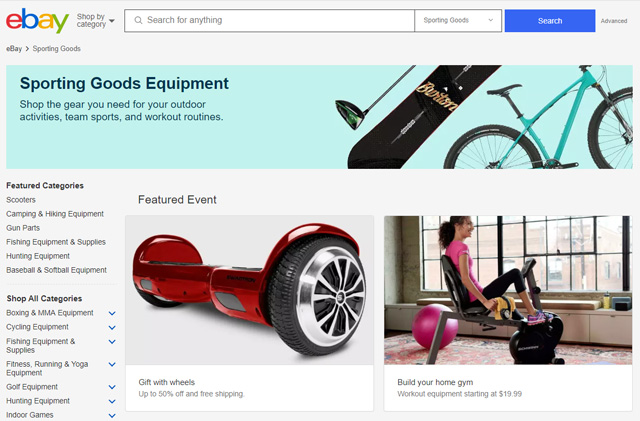
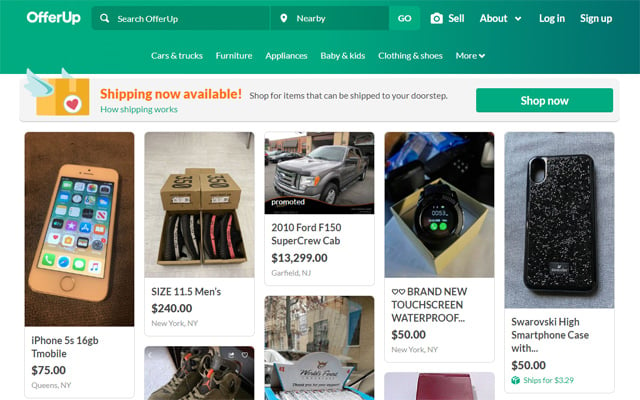
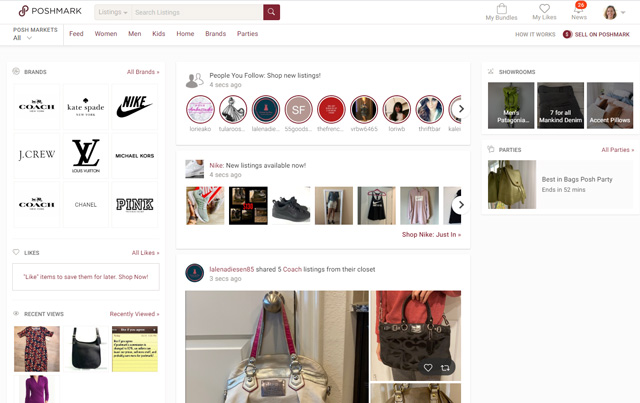
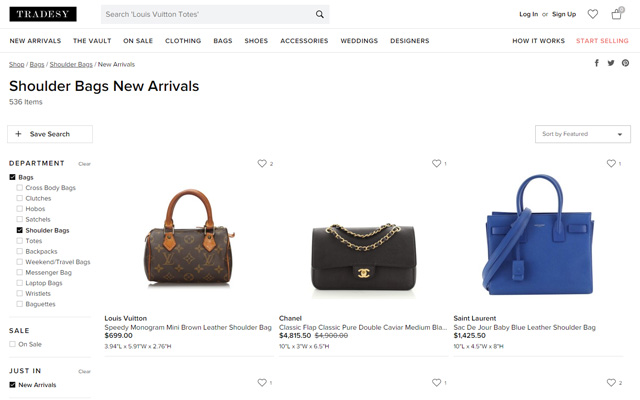
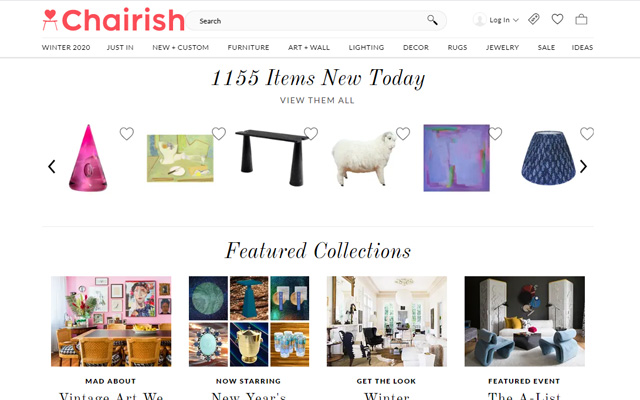
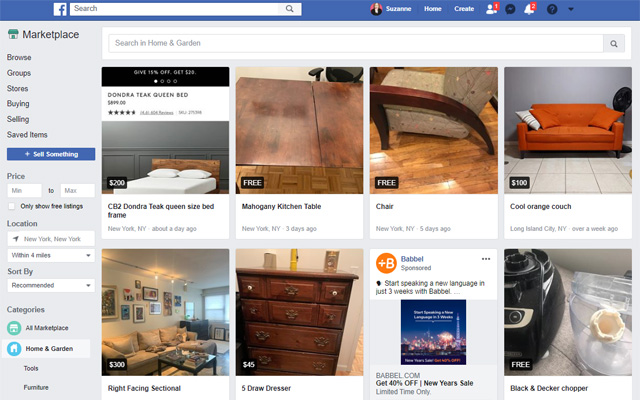
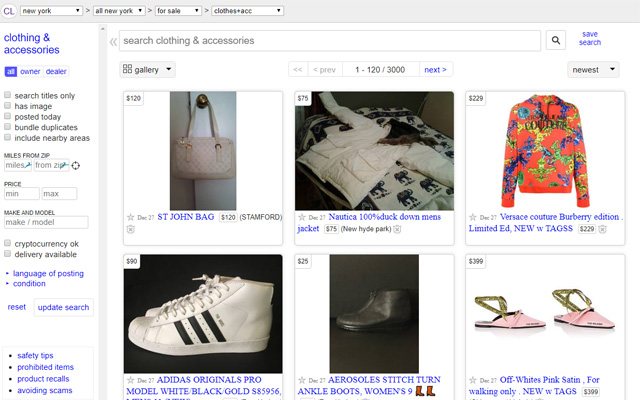













From DaisyStar on January 10, 2016 :: 2:26 am
I’ve been having really low craigslist traffic this year - I’m told that many of the colleges block it (meaning half of the internet users in my city cannot access craigslist). Switching to offerup and backpage. Also noticed that craigslist “refresh” wasn’t sending listing to top, and there’s vendors that bury my ads under dozens of multiple spam ads. 4/5 of craigslist customers are also “fake check” scammers.
Reply